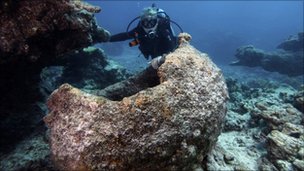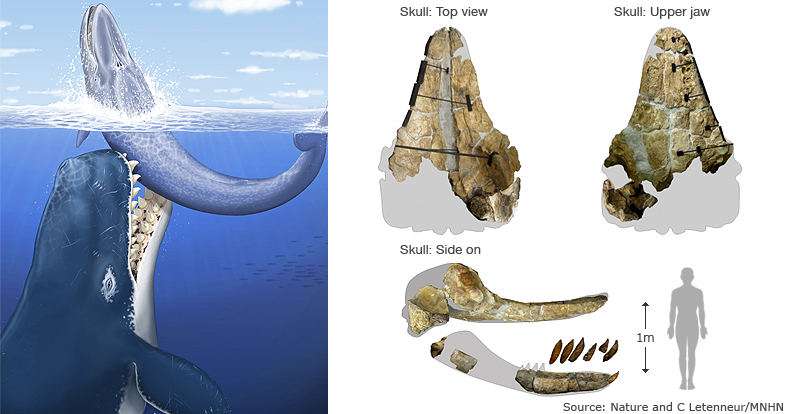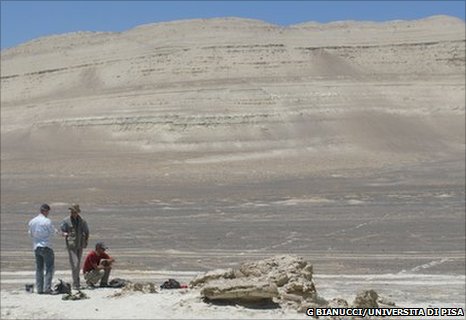|
|
||
|
..
The researchers found large pots used to turn whale blubber into oil and other items 'Moby Dick'
Captain's Ship Found
US marine archaeologists have found the sunken whaling ship belonging to the captain who inspired Herman Melville's classic 19th Century novel, Moby Dick. The remains of the vessel, the Two Brothers, was found in shallow waters off Hawaii. Captain George Pollard was the
skipper when the ship
hit a coral reef and sank in 1823. His previous
ship, the Essex, had been
rammed by a whale and also sank, providing the
narrative for the book.
The remains of the Two Brothers were found by researchers from America's National Oceanic and Atmospheric Administration (Noaa), about 600 miles (965 km) north-west of Honolulu in the remote chain of islands and atolls. The wooden vessel has disintegrated in the warm waters, but the researchers found harpoons, a hook for stripping whales of their blubber and cauldrons used to turn whale blubber into oil. "To find the physical remains of something that seems to have been lost to time is pretty amazing," said Nathaniel Philbrick, an author and historian, who has been researching the Two Brothers, the Essex and their captain. "It just makes you realise these stories are more than stories. They're about real lives." The sinking of the Two Brothers was relatively uneventful compared with the Essex's run-in with the sperm whale in 1821. After the Essex sank, Capt Pollard and his crew drifted at sea without food and water for three months and even resorted to cannibalism before they were rescued. Pollard gave up whaling and became a night watchman in Nantucket, Massachusetts. While Meville was inspired by Pollard's adventures, the unlucky seafarer's character is not thought to have been the basis for the novel's obsessive Capt Ahab. - BBC News SOURCE: BBC News Related Stories:
|
||
|
..
'Sea monster'
whale fossil unearthed
Researchers have discovered the fossilised remains of an ancient whale with huge, fearsome teeth. Writing in the journal Nature, the scientists have dubbed the 12 million-year-old creature "Leviathan". It is thought to have been more than 17m long, and might have engaged in fierce battles with other giant sea creatures from the time. Leviathan was much like the modern sperm whale in terms of size and appearance. But that is where the similarity ends. While the sperm whale is a relatively passive animal, sucking in squid from the depths of the ocean, Leviathan was an aggressive predator. According to Dr Christian de Muizon, director of the Natural History Museum in Paris, Leviathan could have hunted out and fed on large sea creatures such as dolphins, seals and even other whales. "It was a kind of a sea monster," he said. "And it's interesting to note that at the same time in the same waters was another monster, which was a giant shark about 15m long. It's possible that they might have fought each other". The researchers speculate that Leviathan was able to feed on very large prey up to 8m long. It would catch the prey in its huge jaws and tear it apart quickly and effectively with its giant teeth.
A 3m-long fossilised skull of the creature was discovered by researchers in southern Peru in 2008. Dr de Muizon's student, Olivier Lambert was among them. "It was the last day of our field trip when one of our colleagues came and told us that he thought he'd found something very interesting. So we joined him and he showed it to us," he said. "We immediately saw that it was a very large whale and when we looked closer we saw it was a giant sperm whale with huge teeth." The teeth were more than twice the length and diameter of those found in modern sperm whales and they were on the upper and lower jaws. Sperm whales only have teeth on their lower jaw. Dr Lambert and his colleagues had speculated that such a fierce creature might once have existed on the basis of discoveries of individual teeth. Now, the discovery of the skull means that the Leviathan is not merely the stuff of myth and legend. "Finally we found it," said Dr Lambert. " It was a very exciting moment". The researchers do not know why this ancient whale died out. They speculate that the ecology and environment changed so that the creature had to change its feeding habits. That may have led to the emergence of today's much gentler sperm whales, with the carnivorous niche filled by killer whales as conditions swung back again. The authors of the report in Nature, who are all whale experts, are fans of the novel Moby Dick, which involves a ferocious white sperm whale. So taken are they with the novel that they decided to dedicate their discovery to the author, Herman Melville, and give the creature its full scientific name of Leviathan melvillei. SOURCE: BBC News Related Stories:
|
||
| FAIR USE NOTICE: This page contains copyrighted material the use of which has not been specifically authorized by the copyright owner. Pegasus Research Consortium distributes this material without profit to those who have expressed a prior interest in receiving the included information for research and educational purposes. We believe this constitutes a fair use of any such copyrighted material as provided for in 17 U.S.C § 107. If you wish to use copyrighted material from this site for purposes of your own that go beyond fair use, you must obtain permission from the copyright owner. | ||
|
|



